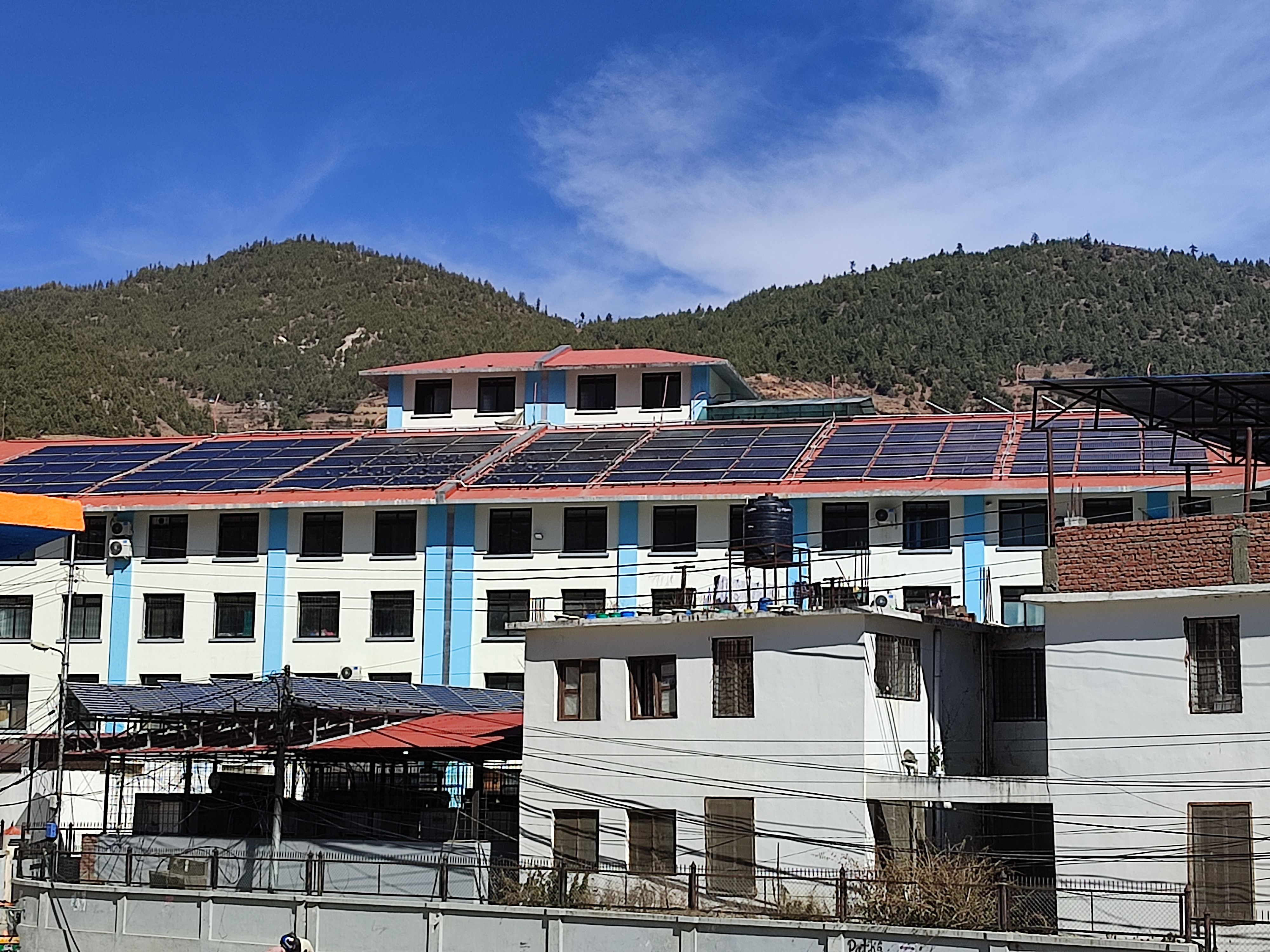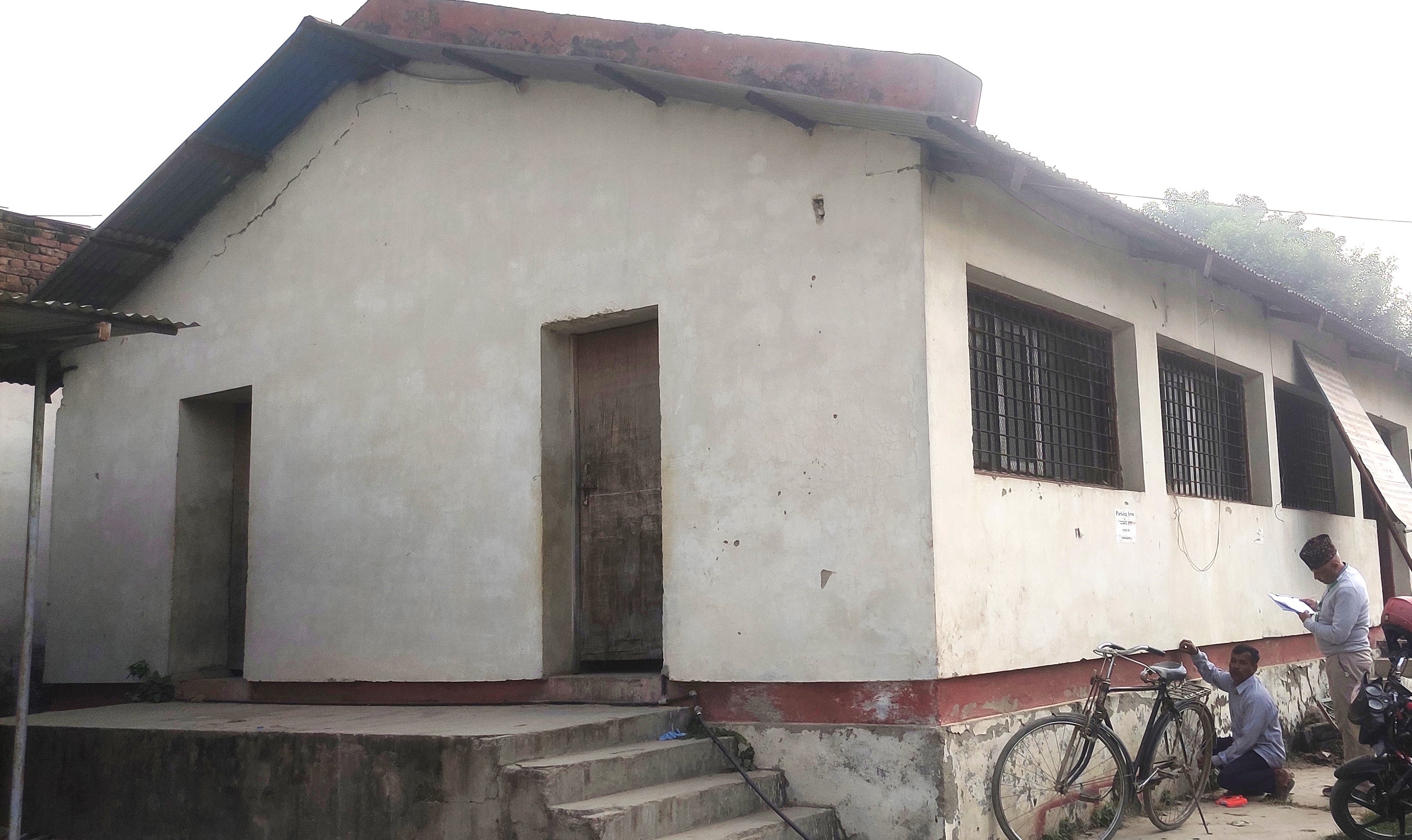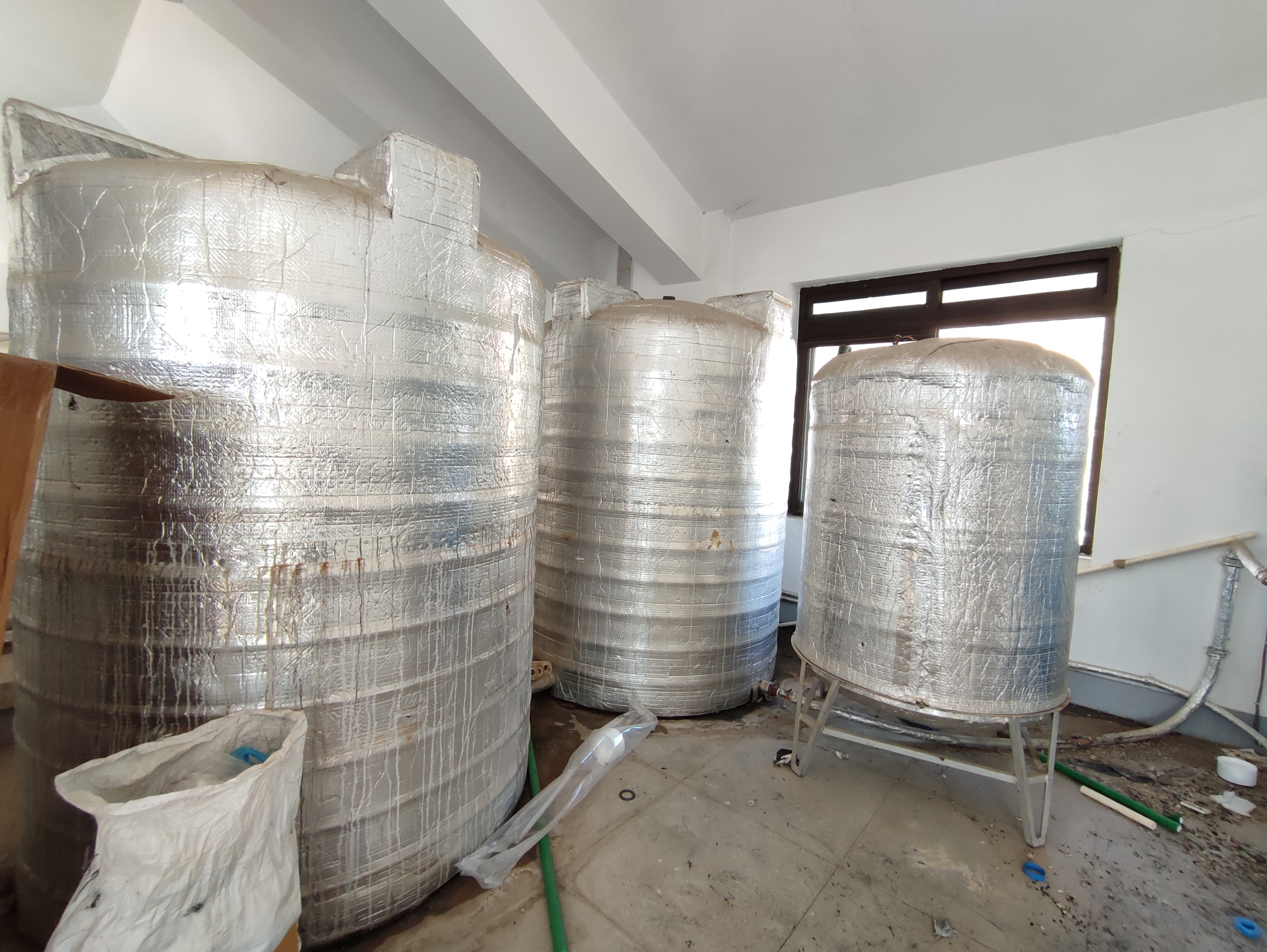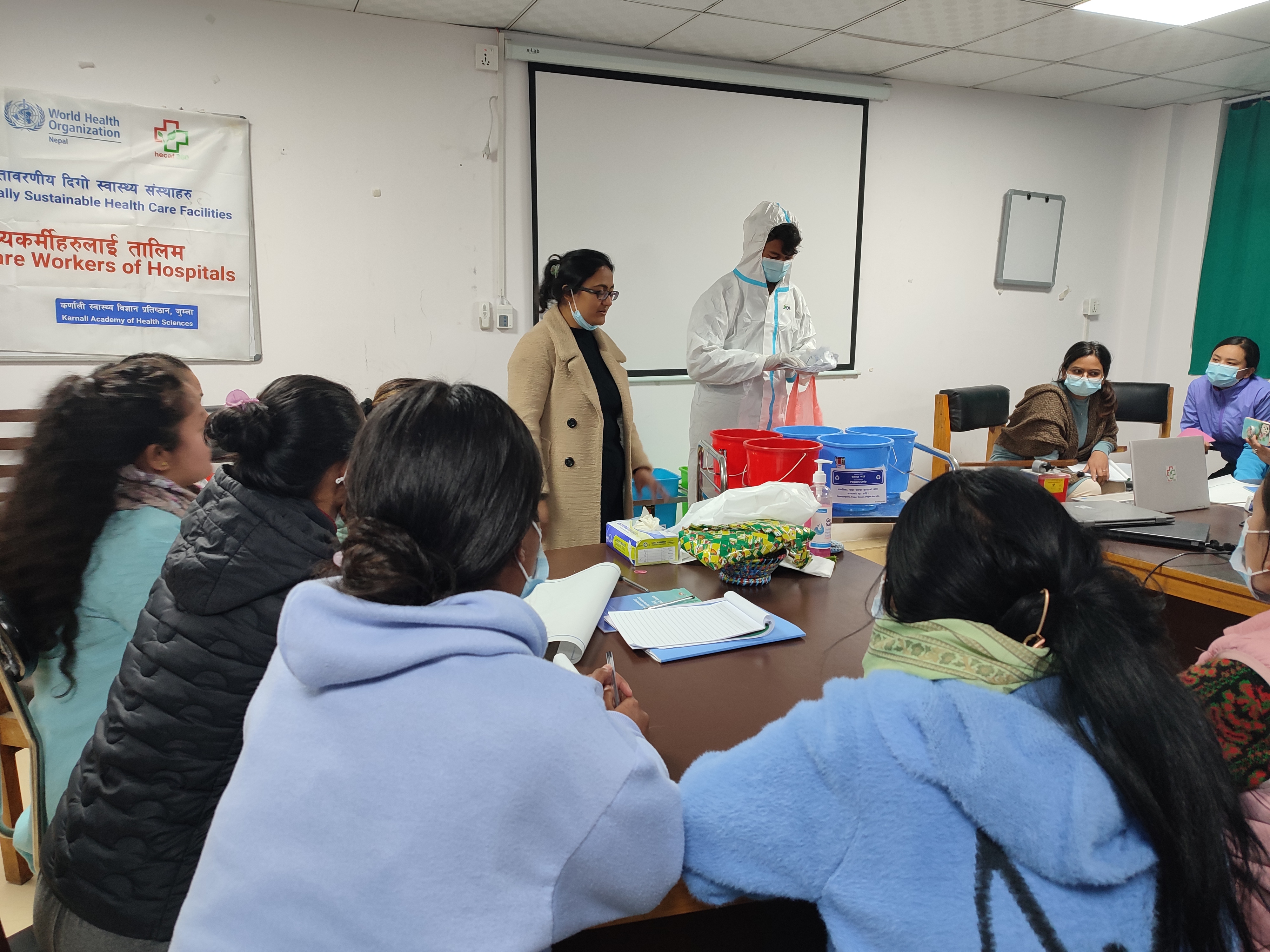Climate disaster mitigation and community resilence through sustainable health care in 3 ecological regions
Karnali Academy of Health Science, Dhaulagiri & Gaur hospitals, Nepal
Case study summary
This case study summarizes a pilot project led by the Department of Health Services, supported by World Health Organization, and implemented by Health Environment and Climate Action Foundation (HECAF360) on identifying the major climate-induced disasters in health care facilities in three ecological regions of Nepal. Assessment included their adaptation and mitigation practices to combat the effects of climate change. This project also frames a four-pillar improvement plan focused on developing climate resilience and environmentally sustainable health care facilities recommended by WHO.
Demographic information
- Hospital names: Karnali Academy of Health Science/ Dhaulagiri Hospital/ Gaur Hospital
- Cities: Chandannath/ Baglung/ Rautahat
- Provinces: Karnali/ Gandaki/ Madhesh
- Regions: Mountainous/ Hilly/ Terai/Plain land
- Country: Nepal
- Type of institutions: 1 teaching hospital, 2 provincial hospitals
- Number of beds: 300 / 50 (126 operating)/ 50
- Number of staff:
- Full-time: 81/ 165/ 24
- Part-time: 334/ 205/ 68
- Patients served annually:
- 5, 00,000 / 1, 20,000/ 1,00,000 patients served at each facility respectively
- Geographic areas served:
- Kalikot, Jumla, Mugu, Bajura, Dolpa and Humla
- Parbat, Myagdi, Mustang and Baglung
- Rautahat and Sarlahi
- Health equity concerns experienced by your population:
- Program is focused on building the capacity and engagement of support staff from marginalized communities who are involved in sanitation and cleaning of the hospital premises. Currently, 50% of these staff are female.
- The climate and health information and awareness programs are designed for local communities to improve their environment while securing services from the health care sector.
- This project aims to improve the adaptation and resilience of the facilities to ensure they can serve the needs of their community during extreme weather and natural disasters.
The issue
Nepal is one of the most vulnerable countries to climate-induced events, having already seen an increased prevalence of vector-borne diseases, diarrheal and respiratory diseases, cardiac and mental illness, and food and water insecurity. Health care systems are at the forefront of dealing with these health issues but are not immune to climate impacts creating a lack of access to health services for patients and local communities. It is imperative that health care facilities establish effective adaptation strategies, as they bear the brunt of climate-related impacts. A comprehensive understanding of climate change and health vulnerability is needed for hospitals to commit to and prioritize adaptation and mitigation actions to achieve climate resilience and environmental sustainability.


This was a very new and unexpected topic for me. Before the program, I was totally unaware of climate change’s impacts on the health sector. I learned that addressing climate change is a must, especially where climate-induced disasters are very frequent. The project is in its initial stage and hope this project will lead to a model for climate-resilient and sustainable hospitals in Nepal.
Hospital goals
The project aims to:
- To assess the status of the four pillars of climate resilience and environmental sustainability of health care facilities (CRESH) in three health care facilities.
- To pilot the WHO guide on CRESH and adapt feasible interventions to fit Nepal's unique needs.
- To implement immediate actions in pilot health care facilities in three ecological regions.
Sustainability strategy implemented
HECAF 360 has designed the project with an exit strategy so that hospital staff are capable of continuing the system implementation plan and working to improve it. Key components include:
- Buy-in from all the stakeholders (all levels of government including federal, provincial, and local, as well as hospitals, the local community, and the academic sector).
- Institutionalization of the concept via key committees and leadership.
- Capacity building (training, orientation, and public awareness).
- Participatory approach in every process of implementation.
- Mobilize youth and students to raise awareness.
- Develop resiliency of hospital operations to increase accessibility of health services during disasters.


Implementation process
The pilot phase started in September 2022 and ended in September 2023. The advisory group was formed at the federal level and held responsibility for site selection and project monitoring and supervision. After approval of the methodologies and plans, an assessment determined the status of the four pillars of CRESH (health workforce, energy, WASH including health care waste management, and infrastructure). The findings were eye-opening for management in all three hospitals to understand the issues. HECAF360 and a designated hospital team co-developed an improvement plan for immediate actions to address identified issues within an ecological and geographical context. The hospital committed to leverage the budget for the construction of a health care waste management center, which was a huge shared investment. Each of the hospitals maintained a waste management committee in line with the pillars of CRESH. The HECAF360 team provided an educational package for staff on climate and health, which helped communicate with the local community. Training has contributed to a behavioral change among staff on CRESH-related practices such as energy and water conservation, waste segregation, prevention of waste burning, and WASH improvement on the basis of national standards.

Flood is the frequent climate-induced disaster that affects our services. During this, we had a big problem with waste management since the waste was washed away by the flood, and had to mitigate the effect of flood. Now the waste management center's design has been improved by raising the plinth height.
Tracking progress
Ongoing decisions and commitments to action were recorded and tracked through registration sheets and meeting minutes. Field and progress reports were prepared to document the activities. To measure HECAF360’s advocacy on climate and health, the number of staff trained/oriented were recorded.
The data collection tools co-developed with Health Care Without Harm and HECAF360 will be used and analyzed to obtain useful findings. Health cost reductions due to interventions will be calculated based on WHO data estimates. In future implementations, all data related to reductions in carbon emissions, waste to landfill, and burning will be analyzed to track achievements in addressing climate change.
Progress achieved
Project leaders were successful in gathering buy-in from stakeholders at different levels of government and hospitals. Pilot hospitals now have a permanent committee on health care waste management. As of March 2023, the project has trained 69 medical staff, 65 support staff, 55 medical doctors and administrators, and more than 30 public health students on climate issues impacting the health sector.
Hospital plumbing and maintenance staff were trained on immediate improvements to and maintenance of the facility infrastructure and WASH facilities. As a result, the hospital has stopped the practice of open waste burning.
This project is also monitoring behavior changes related to water and energy consumption. In the future, energy savings will be calculated.
Initial dialogue has begun with the academic section of one of the hospitals to mobilize public health students to improve awareness of climate and health in the local community.

Challenges
- Staff behavior and attitude.
- Lack of allocated funds and resources in the hospital’s annual budget.
- Lack of priority and acceptance of the issues.
Lessons learned
- Every project should create a good governance structure to develop the institutional memory and continued buy-in from stakeholders.
- The project should develop and maintain a continuous scientific monitoring system for the sustainability of interventions.
- A participatory approach based on the education of all stakeholders is key to buy-in and teamwork.

Nepal is one of the 50 countries committed to developing climate-smart healthcare. [We have learned that] context-specific knowledge is vital in making changes and progress within the local system coupled with support and leadership from the federal government (Nepal’s Department of Health Services)]. Also, the support from the pilot sites is a great achievement that has contributed to the initiation of the addressing the health sector issues through a climate lens. We found that leadership and ownership are the keys to fruitful change.
Next steps
- Implementation of health care waste management systems at pilot hospitals to reduce and measure carbon footprint.
- Improvement of WASH facilities as per the standard.
- Increase awareness of a preparedness plan to enhance hospital capacity to cope with climate-induced disasters and disease outbreaks.
- Conduct an educational program in the local community to synergize the hospital and community relationship to further mitigate climate change and related disasters.
- Preparation of case studies and documentation process.
